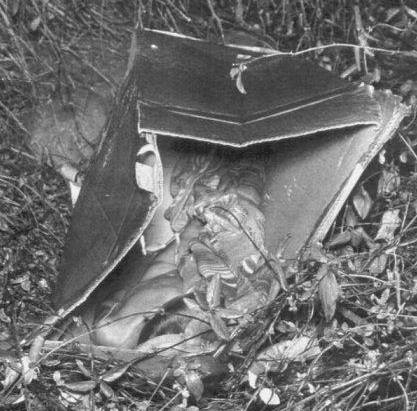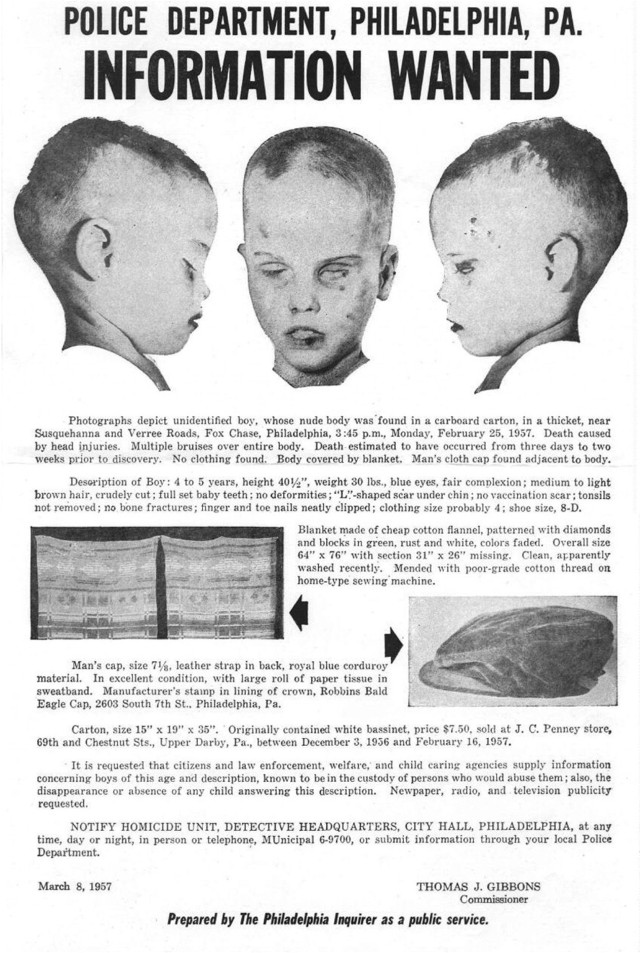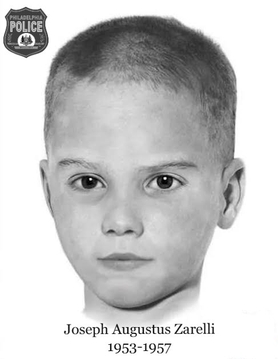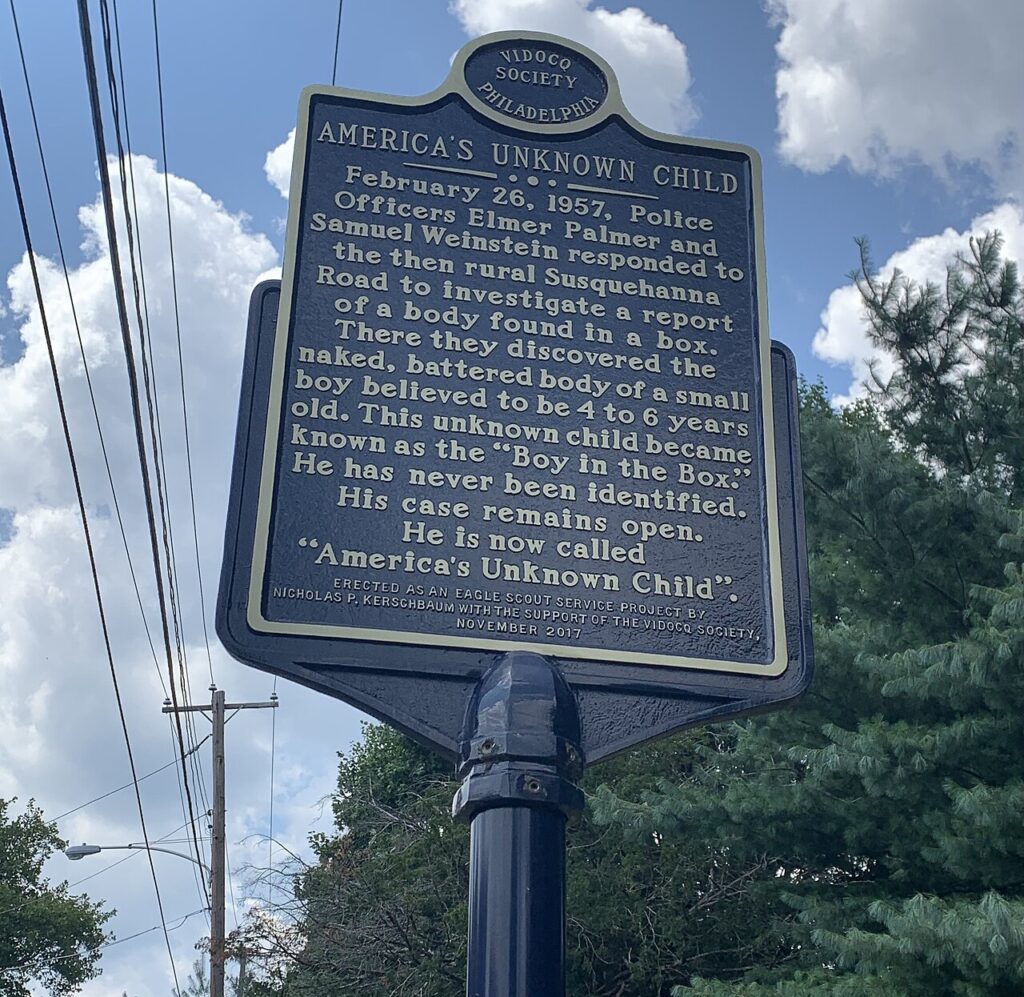
The day Philadelphia lost its innocence
It was February 25, 1957, when a young man walking through a weedy lot on Susquehanna Road noticed something strange. A large cardboard box sat dumped among the trash, half-hidden by brush and winter’s dead leaves.
Inside was a sight that would haunt the city for decades: the small, battered body of a boy.
He looked no older than four or five. He was naked, bruised, and wrapped crudely in a plaid blanket. His hair was recently, almost violently, chopped short—as if someone had tried to disguise him.
Philadelphia police quickly descended on the scene. Reporters followed close behind. But what they found only deepened the mystery.
No shoes. No clothes. No notes. No one had reported a missing boy matching his description.
The box itself — a J.C. Penney bassinet carton — offered no solid leads either. Hundreds had been sold in the region. Tracking them was like chasing smoke.
Still, the police refused to give up.
They took fingerprints. They measured scars. They documented every mark: a healing surgical incision on the boy’s ankle, another on his groin, and a faded L-shaped scar under his chin.
Nothing matched. No missing child alert fit. The boy’s identity, like his life, was already slipping away.
A city desperate for answers
Philadelphia pulled out all the stops.
Posters of the boy’s face went up across the city. His autopsy photo — softened to make him look more peaceful — was mass printed on flyers. People mailed in tips from across the country.
Police officers scoured every orphanage, foster home, and hospital record. They checked reports of runaway children. They interviewed dozens of families who had lost sons, hoping for even the faintest thread.
Nothing.
Lead after lead crumbled. Eyewitness reports turned to dust. Hopes raised by promising tips collapsed under scrutiny.
One officer, Lieutenant William Kelly, was so disturbed by the boy’s lonely fate that he insisted on paying for the child’s funeral himself. When they buried him in Potter’s Field, his gravestone simply read:
“Heavenly Father, Bless This Unknown Boy.”
Philadelphia mourned a child it never even knew.
But mourning eventually gave way to obsession.
And obsession, as it often does, birthed theories.
Theories, guesses, and the foster home
The first major theory focused on a foster home not far from where the boy was found.
The home’s owner, Arthur Nicoletti, ran a kind of informal adoption and foster service, caring for children — sometimes unofficially, sometimes under murky arrangements. Investigators quietly poked around, but nothing concrete ever emerged. No hard evidence. No confessions.
Still, local whispers grew.
Had the boy lived at the home? Had something gone wrong, prompting a hasty cover-up? Had his body been discarded when they realized no one would claim him?
There were hints, but nothing solid enough to charge anyone.
The boy, it seemed, had no champion. No advocate to demand justice. Just police sketches and a cardboard box rotting in the back of people’s memories.
As months turned into years, and years into decades, the city’s attention drifted elsewhere.
But the case never really died.
It simmered underground, waiting for the world to catch up.
A mystery that outlived its witnesses
Time is the enemy of unsolved crimes. Witnesses forget. Paper trails vanish. People die.
By the 1980s, many of the original investigators had retired or passed away. Leads went cold for good.
Still, a handful of citizen sleuths refused to let go.
People like Frank Bender, a forensic artist, who created a new facial reconstruction in the 1990s. He believed if people could see the boy smiling, he might finally be recognized.
And organizations like the Vidocq Society — a club of retired detectives, forensic experts, and investigators — took up the case, pouring thousands of volunteer hours into finding the truth.
They followed every strange clue, no matter how bizarre.
There was the woman known as “M,” who claimed her abusive mother had purchased the boy, abused him, and then killed him in a fit of rage. Investigators found parts of her story plausible but ultimately unverifiable.
Another theory suggested the boy might have been raised as a girl, which could explain the odd haircut and surgical scars. But again, speculation outpaced evidence.
The deeper people dug, the more they found — and the less they understood.
It was like the boy had been erased on purpose.

DNA: The technology that changed everything
In the early 2000s, hope arrived in the form of technology that hadn’t existed when the boy was first found: DNA analysis.
His body was exhumed, carefully, respectfully. Scientists extracted mitochondrial DNA — the kind passed down through the mother’s line — hoping to find a match.
At first, the results were disappointing. No hits. No close relatives popped up in the databases.
But DNA technology wasn’t finished evolving.
By 2020, a revolutionary new method called genetic genealogy — combining DNA with family tree research — had cracked cases once thought unsolvable, like the Golden State Killer.
Detectives turned to this new tool with fresh hope.
The Boy in the Box was about to finally speak.
A name reclaimed after 65 years
It took months of careful work.
Genealogists combed through sprawling family trees, looking for someone — anyone — whose DNA intersected with the boy’s.
The breakthrough came when they found distant cousins living in the Philadelphia area. Slowly, painstakingly, they worked backward through birth records, marriage licenses, and death certificates.
The trail led to a birth certificate from 1953.
The boy’s name was Joseph Augustus Zarelli.
For the first time in 65 years, America’s Unknown Child had an identity.
But even as police stood before microphones in December 2022 to announce the discovery, they admitted that many questions remained.
Joseph had lived. He had a family. Yet somehow, he had disappeared — unnoticed, unreported, abandoned.
How did that happen?
And why had no one ever claimed him?
Those answers were still waiting.

The family that stayed silent
When authorities finally traced Joseph Augustus Zarelli’s family, it wasn’t the ending they had hoped for.
Both of his birth parents were long dead. His mother, identified through DNA links, had been a teenager when Joseph was born. His father came from a prominent local family. Neither had ever reported Joseph missing.
Even more chilling — several of Joseph’s relatives were still alive.
The police confirmed it gently: “We know who they are. Some of them are aware. Some are not.”
But no one came forward publicly. No tearful press conferences. No apologies. No explanations.
For Joseph, even with a name, the silence continued.
A birth into secrets
Joseph had been born into complicated circumstances.
In the 1950s, having a child out of wedlock was a heavy shame, especially in conservative, Catholic families like those in Philadelphia’s working-class neighborhoods. A teenage pregnancy could derail entire lives.
Sometimes the solution was to quietly give the baby away — to relatives, to informal foster homes, to people who could “handle it.”
Sometimes the child simply disappeared from the family story, as if he had never been born at all.
Detectives believe Joseph may have been raised outside his birth home. Possibly bounced between guardians. Possibly neglected.
At some point, for reasons no official report has yet dared spell out, Joseph’s short life ended violently.
And no one came looking for him.
The weight of vanished children
Joseph’s case wasn’t just a failure of one family. It was a mirror held up to mid-century America.
In the 1950s, the machinery of the state — police, social services, hospitals — assumed families took care of their own. Poor kids, especially, could vanish with little official notice.
Runaways weren’t always reported. Missing kids weren’t always investigated unless someone pushed.
If no one claimed a child, the system simply…moved on.
The Boy in the Box exposed that brutal reality in the most heartbreaking way.
He didn’t fall through the cracks.
He was never given a crack to fall through.
Why the haircut still haunts investigators
One of the strangest details from the crime scene was Joseph’s hair.
It had been hacked away — uneven, rough, almost angry.
Investigators believe the haircut happened either shortly before or after death. Was it an attempt to hide his identity? To confuse witnesses who might have recognized a curly-haired child?
Or was it something darker — a punishment, a final humiliation?
Decades later, seasoned detectives still shudder at that detail. It was personal. Intimate. Not something a stranger would likely do.
Whoever left Joseph in that box probably knew him.
And probably felt desperate enough to erase him completely.
No justice, only remembrance
In 2022, when police announced Joseph’s name, they also admitted something else.
There would probably be no arrests.
The key suspects — whoever had custody of Joseph when he died — were likely dead. Statutes of limitations on manslaughter or neglect had long expired. Only a murder charge could be pursued, and without a confession or clear evidence, it would be impossible to prove.
The case had shifted from a whodunit to a memorial.
Joseph’s gravestone was updated. His tiny plot, long marked only by a prayer, now bore his real name.
Visitors began leaving toys, flowers, even hand-written notes at his grave.
Sixty-five years late. But not too late.
The boy who shaped forensic science
In a strange way, Joseph’s case helped push forensic science forward.
His case was among the first to use media blitz campaigns to try to identify a child nationally. It inspired early conversations about national missing persons databases, better tracking of unidentified remains, and forensic facial reconstruction.
Later, when DNA technology matured, Joseph became one of the earliest high-profile cases to attempt mitochondrial DNA extraction from degraded remains.
Without Joseph, it’s possible that other lost children — like the famous “Little Miss Nobody” case in Arizona — might have stayed nameless even longer.
Joseph became a symbol for the forgotten. A quiet ambassador for all the children the world had failed.
The questions that still ache
Even now, Joseph’s story refuses to settle neatly into history.
Hard questions remain:
Who exactly was responsible for his death?
Why wasn’t he reported missing?
Were there people who knew the truth all along but stayed silent?
Some believe the full story still lives, whispered across generations inside Joseph’s extended family. A heavy secret buried deeper than any grave.
But others think the truth may be lost forever — another thing time has stolen.
What remains is this:
A little boy. A cardboard box. And a city that never forgot him.

A legacy born of sorrow
Joseph’s real victory, if you can call it that, lies in what came after.
He didn’t vanish.
Not really.
For 65 years, strangers carried his memory forward. Police officers who refused to close the file. Retired detectives who pored over old notes. Genealogists who spent years painstakingly tracing distant bloodlines.
And ordinary people — the ones who left teddy bears at his grave, lit candles, whispered prayers.
Joseph’s case became a rare kind of communal promise:
That even the forgotten deserve a name.
That even the discarded deserve dignity.
He wasn’t just the Boy in the Box anymore.
He was Joseph.
He mattered.
And somehow, after all the silence, the world heard him.






Why is the father not named? I guess whatever privilege allows people like that to get away with things like this still protect them after the fact…
probably because the father wasn’t known. given how they handled teenage pregnancies back then, He may have not even known about the kid.
MAN THIS MADE ME SICK TO THINK I WAS BORN ABOUT 7 YRS. AFTER HIM WHAT A DIFF. TIME MAKES, CRYING AND JUST SICK TO MY STOMACH, EXCUSE ME WHILE I GO THROW UP, BLESS THE LITTLE BOY JOSEPH
Whoever wrote this article is the most poetic person on Earth I’m tearing up. BECOME AN AUTHOR PLEASE! I hope Joseph’s ghost found these touching words and realized his self-worth. He was born on the planet “unwanted” but he leaves a sorrowful legend with more love than any celebrity
I agree with what someone else said. This is so well written. Thank you for this tribute to little Joseph. I hope you are writing more such articles and even books. I remember reading about his names being discovered and thought it was both a happy and sad day. This child deserved to have his name recorded, but he also deserves justice. The time for social embarrassment has passed. If you are a member of Joseph’s family, be a hero and help the police out. People will applaud you for doing the right thing.